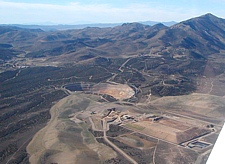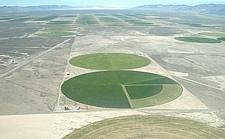THE ECONOMY
Gold mining continues as the principal economic engine of Eureka County. Over the period 1993 - 2017 there were three primary gold producing areas in the County. In 2002 Eureka County produced 37 percent of all gold produced in Nevada, and in 2012 the county produced 33 percent of all Nevada gold. By 2016 gold production dropped to 27.34 percent. Two mine complexes in northern Eureka County continue to be some of the most productive mines in Nevada and indeed in the entire country, with Newmont Mining Corporation's Carlin Trend mines producing nearly 1.5 million ounces of gold in 2016, and Barrick Gold Corporation's Betze-Post Mine producing over 934,000 ounces in that year. Barrick is developing and has begun to mine deposits in the Cortez Hills and further south in Horse Canyon area. Mining jobs continue to surpass all other Eureka County jobs combined, with 4,092 of the total 4,507 jobs in the County reported by the Nevada Department of Employment Training and Rehabilitation in 2017.

During the late 1990's, lower gold prices caused many Nevada mines to scale back exploration and to scale back or temporarily close some operations. Since then the price of gold has again risen to over $600 per ounce in 2006 and reaching a peak of $1,900 in 2011 declining to $1,350 per ounce in 2018. Because of higher gold prices, several Nevada gold mines are expanding both operations and exploration. As of the end of 2017 Newmont Mining Corporation's Carlin trend mines had almost 14.83 million ounces of gold in proven and probable reserves.
Barrick’s Cortez Hills mine located in southern Crescent Valley is producing gold from the leach pad and has started stripping the pediment deposit that will join the Cortez Hills pit to make one open pit. The Cortez Pipeline project located just over the Eureka County line in Lander County continues producing gold. With 2018 production of 1.73 million ounces at total all-in sustaining costs of $610-$650 per ounce, Cortez is one of the world’s largest and lowest cost gold mines, and the property also has excellent upside exploration potential. Barrick’s Horse Canyon/Cortez unified project (Gold Rush Deposit) is the company’s next flagship project located six kilometers from the Cortez mine, and is one of the largest and highest-grade gold discoveries of the last decade. 2017 proven and probable reserves stand at 10.09 million ounces. Exploration continues in the Cortez District.
Eureka Moly, LLC plans to develop the Mount Hope project approximately 23 miles northwest of Eureka. The 80-year Mount Hope Project will have a 24-month construction phase, 44 years of mining and ore processing, 30 years of reclamation, and five year of post-closure monitoring. The Mount Hope ore body contains approximately 966 million tons of molybdenite ore that would produce approximately 1.1 billion pounds of recoverable molybdenum during the ore processing time frame. The mine plans to employ approximately 400 during operations.
 Agriculture remains a steady economic element in Eureka County. Unlike mining, agriculture has been a consistent base of economic activity in Eureka County, particularly in the Diamond Valley area. The agricultural economy consists of four sectors: range beef cattle, alfalfa hay, timothy hay, and native hay. There were 101 farms or ranches in the county in 2012, producing about $36 million in agricultural products. This is an increase in the number of farms/ranches from 73 in 2002. The average per farm/ranch market value of agricultural products sold in 2012 was $356,636. The cattle and calves inventory has fluctuated between 18,000 and 25,000 head over the last several years. Total hay production has declined somewhat since 2011. Extended drought conditions have had an impact on both hay and cattle numbers.
Agriculture remains a steady economic element in Eureka County. Unlike mining, agriculture has been a consistent base of economic activity in Eureka County, particularly in the Diamond Valley area. The agricultural economy consists of four sectors: range beef cattle, alfalfa hay, timothy hay, and native hay. There were 101 farms or ranches in the county in 2012, producing about $36 million in agricultural products. This is an increase in the number of farms/ranches from 73 in 2002. The average per farm/ranch market value of agricultural products sold in 2012 was $356,636. The cattle and calves inventory has fluctuated between 18,000 and 25,000 head over the last several years. Total hay production has declined somewhat since 2011. Extended drought conditions have had an impact on both hay and cattle numbers.
The unemployment rate in Eureka County peaked at 10.7 percent in 1994, well above state and national unemployment rates. In subsequent years the unemployment rate fell to a low of 2.5 percent in 2000, then rose again to 7.6 percent in 2010. By 2017, the County unemployment rate dropped to 2.6 percent.
Eureka County has more jobs than workers. The three largest mines in the County are in the far northern end of the county, closer to the towns of Elko and Carlin than to Eureka County's population centers of Crescent Valley and Eureka, so most workers commute to the mines from Elko County communities. Some Crescent Valley residents, however, work at the Cortez Complex Mine, a portion of which is within Lander County. The mining sector appears to affect not only the unemployment rate in the county, but also the size of the labor force itself.
Various income measurements for Eureka County show improving economic conditions. Eureka County per capita income was higher than that of the state overall through 2009. The per capita income reached $40,876 in 2008 before falling to $32,876 due to the national economic downturn and an upward adjustment in Eureka County population. The 2016 per capita income was $34,159. Household income increased from $45,240 in 2005 to $70,000 in 2016.
Total taxable sales in Eureka County are volatile moving up and down based upon activity in the mining sector. Taxable sales peaked in 2007 at just over $500 million. Between 2008 and 2014 taxable sales fluctuated between $370 million and $266 million. In fiscal year 2017 they increased to $292.1 million a rebound from a recent low of $235.1 million in 2016. Taxable sales for mining related items remain by far the county's largest generator of taxable sales. In 2017, metal mining made up a majority of the county's taxable sales. Other top sectors in the county include wholesale trade/durable goods, industrial and commercial machinery, chemical products, and business services.
In the tourism sector, visitation to the Eureka Sentinel Museum has increased over the two decades since its opening, but not steadily. Visitation to the museum reached a high of 5,083 visitors in 1995, and then declined in subsequent years declining to a low of 3,966 in 2016 before rebounding slightly in 2017. Room tax collections climbed continuously through 2007 reaching a peak of $100,110 in 2007. From 1999 to 2013 room tax revenues almost doubled before dropping to 2001-2005 levels. Gaming license collections remain relatively stable fluctuating from high of $174,203 to a low of $55,238 in 2016. From 2013-2017 gaming tax declined nearly 50 percent. Recent declines in gaming tax revenues are partly attributed to national economic conditions. Eureka County continues to pursue diversified economic development including tourism.
|

